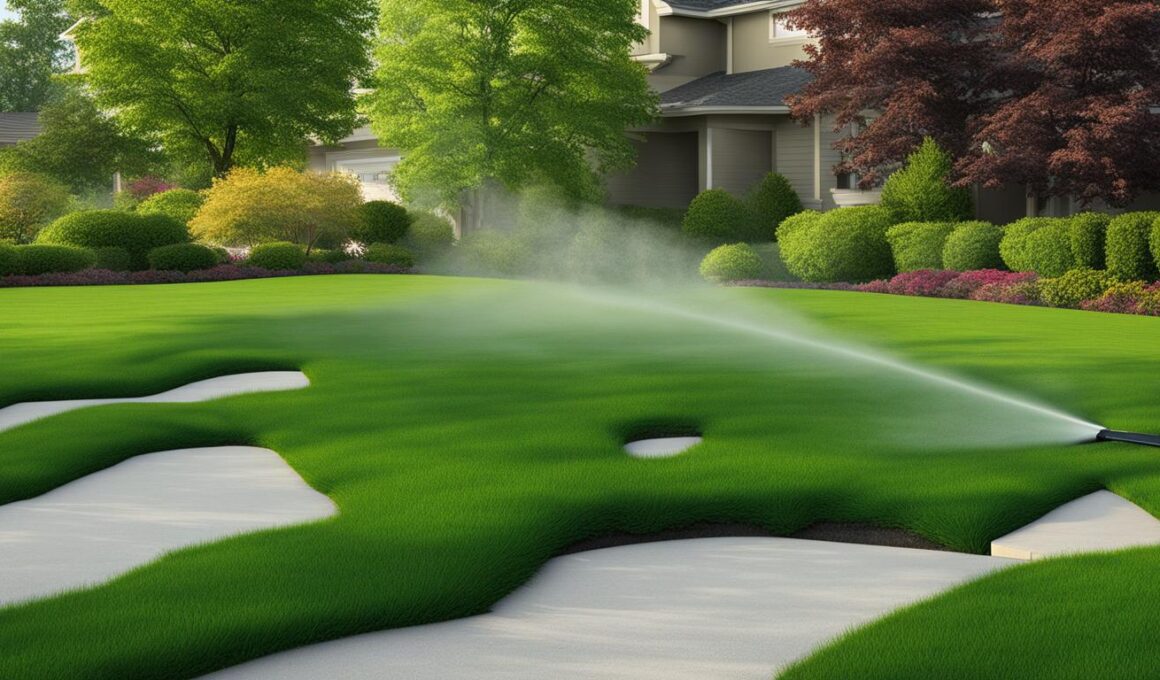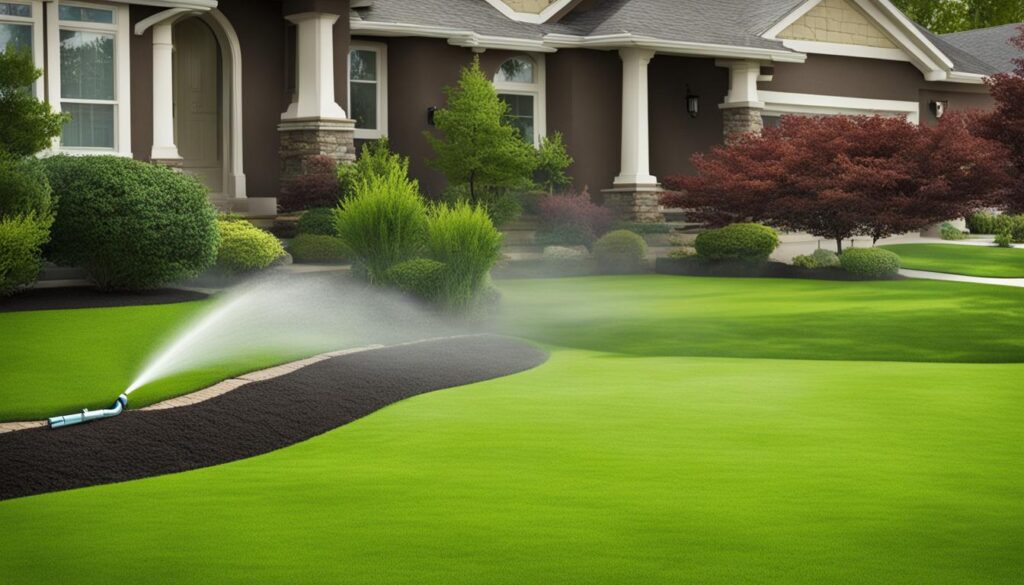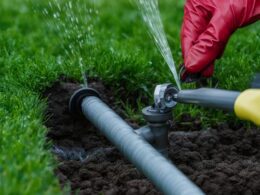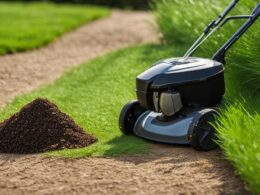Are you considering hydroseeding for your lawn or landscape project? Understanding the cost involved is an essential part of planning. Hydroseeding is a popular method that incorporates a slurry of seed, water, and protective mulch to promote healthy and lush growth. The cost of hydroseeding can vary based on several factors, including the size of your yard and the type of seed mix used.
Key Takeaways:
- Hydroseeding costs homeowners around $0.05 to $0.20 per square foot.
- The national average cost is $1,000, with a range of $515 to $1,910.
- Factors such as seed mix, application rate, method, and aftercare can affect the overall cost.
- Alternative options to hydroseeding include artificial grass and sod, which have different cost ranges.
- If you choose to DIY, the average cost is $0.25 to $0.35 per square foot, with equipment costs ranging from $300 to $650.
Average costs
When considering hydroseeding for your lawn or landscape, it’s important to understand the average costs involved. The national average cost of hydroseeding is $1,000, with a typical range of $515 to $1,910. These costs are based on the size of a typical American yard, which ranges from 5,000 to 20,000 square feet. Yard size is one of the main factors that determine the cost of hydroseeding.
On average, hydroseeding costs homeowners between $0.05 to $0.20 per square foot. This cost includes the hydroseeding process, which involves spraying a mixture of seed, mulch, fertilizer, and water onto the ground to promote lawn growth. The cost per square foot may differ depending on various factors such as the type of seed mix, rate of application, method of application, and aftercare needs.
To give you a better idea, let’s consider a 10,000 square foot lawn. With an average cost per square foot of $0.15, the estimated cost for hydroseeding would be $1,500. However, it’s important to note that the overall cost can vary based on the factors mentioned earlier.
When deciding on hydroseeding, it’s essential to consider the average cost, as well as other contributing factors. By understanding these costs, you can make an informed decision about whether hydroseeding is the right choice for your lawn or landscape needs.
Cost Estimator by Size
One of the factors that can help you estimate the cost of hydroseeding is the size of your lawn. By knowing the square footage of your lawn, you can get an idea of how much you can expect to pay for hydroseeding. Here is a breakdown of the average costs based on lawn size:
- 1,000 square foot lawn: The average cost for hydroseeding a lawn of this size is $150.
- 5,000 square foot lawn: Hydroseeding a lawn of this size typically costs around $750.
- 10,000 square foot lawn: For a lawn of this size, the average cost is approximately $1,500.
These estimates are based on an average per-square-foot cost of $0.15. Keep in mind that these are general estimates and the actual cost may vary depending on factors such as the type of seed mix and the region you are located in.
To give you a better idea of what hydroseeding can achieve, take a look at this image showcasing a beautifully hydroseeded lawn:

Other factors that affect cost
In addition to yard size, there are several other factors that can affect the cost of hydroseeding. These factors include the type of seed mix used, the rate of application, the method of application, and the aftercare needs of the lawn or landscape.
Seed mix cost: Different seed mixtures come at different costs. Specialized mixtures, such as those tailored for shade tolerance or specific climates, tend to be more expensive than standard varieties. It’s important to consider the specific needs and requirements of your lawn or landscape when selecting a seed mix.
Rate of application cost: The rate at which the hydroseeding mixture is applied can impact the overall cost. Higher application rates, which require more seed and material, may result in a higher price. It’s essential to work with a professional who can determine the optimal rate of application for your project.
Method of application cost: The method used to apply the hydroseeding mixture can also affect the cost. Some methods, such as using a specialized hydroseeding machine, may incur additional expenses. Discuss with your hydroseeding provider to determine the most suitable and cost-effective method for your lawn or landscape.
Aftercare cost: After hydroseeding, proper aftercare is crucial for successful establishment. This includes regular watering, fertilizing, and monitoring for any signs of pest or weed growth. The cost of aftercare can vary depending on the size of the area and the specific requirements of the seed mix. Remember to budget for aftercare needs when considering the overall cost of hydroseeding.
Considering these factors – seed mix cost, rate of application cost, method of application cost, and aftercare cost – alongside yard size, will help you determine the total cost of your hydroseeding project.
Related services
In addition to hydroseeding, there are other lawn care services to consider. When hydroseeding is not the ideal option for your lawn, you can explore alternative services like artificial grass and sod. These alternatives provide a low-maintenance and visually appealing alternative to traditional grassy lawns.
Artificial grass, also known as synthetic turf, offers a lush, green appearance without the need for watering, mowing, or fertilizing. The cost of artificial grass can range from $5.50 to $19.75 per square foot depending on the quality and brand. It provides a long-term solution that is durable and resistant to wear and tear.
Sod, on the other hand, is pre-grown grass that is transplanted onto your lawn. It provides instant results and can be an affordable solution for homeowners. The cost of sod typically ranges from $0.90 to $1.80 per square foot, including the cost of installation.
Aside from alternative lawn options, there are additional lawn care services to consider. These services include lawn mowing, fertilization, leaf removal, dethatching, aeration, and general lawn care. Depending on the size of your lawn and the specific services required, the costs for these services can vary.
DIY Cost
If you’re looking to save money on hydroseeding, you can consider doing it yourself. DIY hydroseeding allows you to take control of the process and potentially reduce costs.
On average, DIY hydroseeding costs between $0.25 and $0.35 per square foot, making it a cost-effective option compared to hiring a professional. You can calculate the total cost based on the size of your lawn or landscape. For example, a 1,000 square foot area would cost around $250 to $350.
To get started with DIY hydroseeding, you will need to invest in some equipment and materials. The total cost for equipment typically ranges from $300 to $650, depending on the quality and features you choose.
The essential equipment and materials for DIY hydroseeding include:
- Grass seed: Choose a quality seed that is suitable for your climate and lawn conditions.
- Paper mulch: This acts as a protective covering for the seeds, preventing them from washing away or being eaten by birds.
- Fertilizer: Providing the necessary nutrients to promote seed germination and healthy growth.
- Hydroseeding machine: This is necessary for effectively spraying the seed mixture onto the soil. You can either purchase or rent a machine, depending on your preference and frequency of use.
By taking on the DIY approach, you can not only save money but also have the satisfaction of seeing your lawn or landscape thrive and grow from your own efforts. However, keep in mind that DIY hydroseeding requires proper preparation, knowledge, and attention to detail to achieve the best results.
Cost by Location
The cost of hydroseeding can vary depending on the location. When it comes to hydroseeding cost by location, urban areas tend to have lower prices compared to remote areas. This price difference can be influenced by various factors, such as transportation costs and the availability of resources.
In urban areas, the proximity of suppliers and equipment rental centers may result in lower transportation costs, which can ultimately reduce the overall cost of hydroseeding. Additionally, the increased density of landscaping businesses in urban areas might create more competition, leading to competitive pricing.
On the other hand, in remote areas where resources may be scarce and suppliers are located farther away, transportation costs can increase, thereby affecting the cost of hydroseeding. The limited availability of resources in these areas can also contribute to higher prices.
Therefore, when planning your hydroseeding project, it’s important to consider the location and its impact on the cost. Whether you reside in an urban or remote area, understanding the local market conditions and reaching out to multiple suppliers to compare prices can help you make an informed decision within your budget.
IMG:
Having a clear understanding of the cost by location will allow you to plan your hydroseeding project accordingly, ensuring that you are well-prepared for any potential financial implications.
How Does Lawn Aeration Cost Compare to Hydro Seed Cost for Lawns and Landscapes?
When comparing lawn aeration cost and benefits to hydro seed cost for lawns and landscapes, it’s important to consider the long-term advantages. While hydro seeding can lead to quicker growth, lawn aeration provides essential oxygen and nutrient circulation, promoting healthier, more sustainable grass and landscaping.
Conclusion
When it comes to budgeting for your lawn or landscape project, understanding the factors that influence hydroseeding cost is crucial. The size of your yard, the type of seed mix you choose, the rate and method of application, and the aftercare needs all play a role in determining the overall cost. By considering these factors and making an informed decision, you can ensure that you stay within your budget.
In addition to these factors, it’s also worth exploring alternative lawn services and their costs. While hydroseeding is a popular choice, you might want to consider other methods such as artificial grass or sod. Each option comes with its own cost considerations, so it’s important to weigh the pros and cons before making a decision.
Finally, whether you decide to hire a professional or take the DIY route, budgeting accordingly is essential. DIY hydroseeding may seem like a cost-effective option, but it’s important to factor in the costs of equipment and materials. On the other hand, hiring a professional ensures that the job is done correctly, but it may come at a higher cost.
In conclusion, understanding the various factors that affect hydroseeding cost allows you to make an informed decision about your lawn or landscape project. Consider the size of your yard, the type of seed mix, the rate and method of application, and the aftercare needs. Explore alternative methods and their associated costs. Whether you choose hydroseeding or another method, remember to budget wisely for your project.










